April 30, 2025 | 04:22 GMT +7
April 30, 2025 | 04:22 GMT +7
Hotline: 0913.378.918
April 30, 2025 | 04:22 GMT +7
Hotline: 0913.378.918
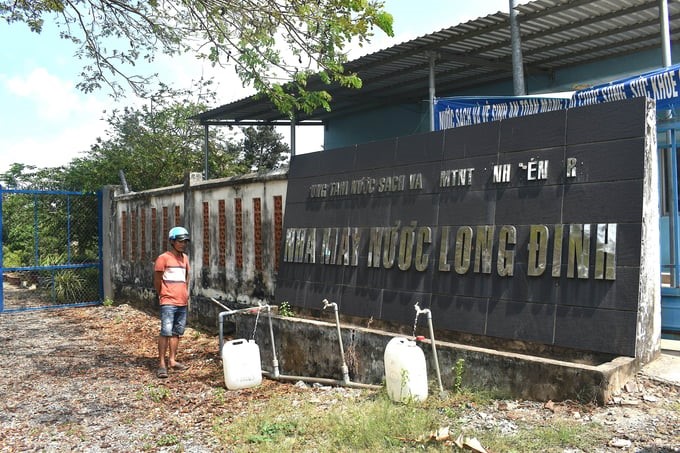
People get water that has gone through the R.O filtration system at the Long Dinh water factory. Photo: Minh Dam.
Talking to the Vietnam Agriculture Newspaper on March 14, people in Giao Long commune, Chau Thanh district, said that the tap water source provided by Chau Thanh Water Supplying JSC has been saline for about a month.
Salinity fluctuates continuously with the tide, but this water source is basically unusable for cooking. Thanks to local dissemination, before salt water intruded deeply, local people proactively stored rainwater and tap water. Many people are using these water sources.
Being able to store several large jars of rainwater, Mr. Pham Van Thoai's family in Hoa Long hamlet, Giao Long commune, still has enough water for bathing, washing, and cooking during this dry season. “Tap water is still salty, and at night it's slightly insipid. A week ago, it was possible to bathe in tap water, but now whenever I bathe in tap water, I will be ichy. From the house to the road, there is a free water supply station, but my family does not need to use it yet because we still have enough water to bathe until the end of the dry season," Mr. Thoai said.
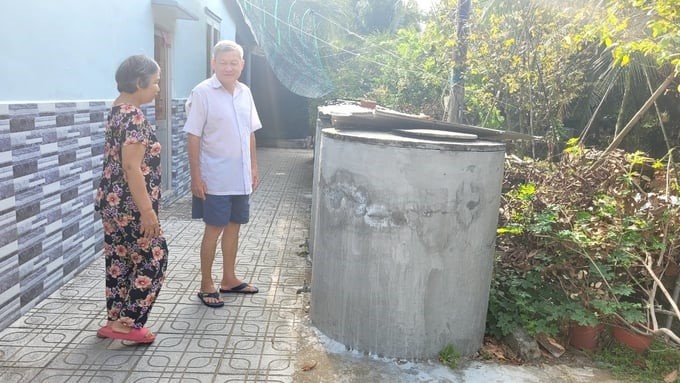
Ben Tre people store fresh water and rainwater in jars. Photo: Minh Dam.
However, in the locality, there are still many households that do not have the conditions to store much water, so they extremely lack fresh water, especially among workers working near Giao Long industrial park.
On the morning of March 14, at a free fresh water supply station of Chau Thanh Water Supplying Company (Long Hoa hamlet), Ms. Tran Thi Thu Trang, a local resident, was busy filling a 30-liter plastic can and putting on the bike to walk home.
Ms. Trang said tap water is now very salty and cannot be used. Chau Thanh Water Supplying Company has just set up field water supply stations like this for people to take for cooking and bathing for nearly a week. Even though she has to take her bike to get liters of water every day, Ms. Trang seems optimistic because it is still cheaper than having to buy expensive water in a bottle.
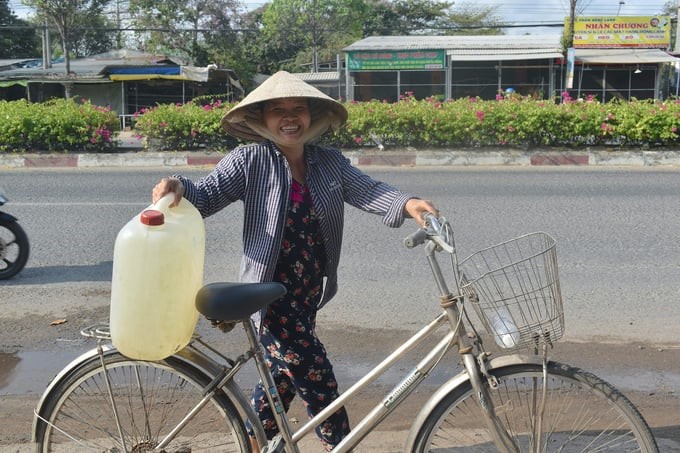
Ms. Tran Thi Thu Trang takes her bike to get fresh water. Photo: Minh Dam.
“Salt water is only used to wash our hands and feet, but when bathing, we have to rinse with fresh water. It has been a few years since this salty season happened again," Ms. Thu Trang said.
Ms. Nguyen Thi Hieu, a worker staying at Long Thanh hamlet, Giao Long commune, said salt water has a significant impact on her life. When used to cook rice, salt water makes rice stale quickly; when used to cook soup, the soup is salty and unedible. When she used salt water to take a shower, it made her so itchy that she couldn't sleep. She only dares to use salt water to wash old clothes, but absolutely not new clothes. "I hope the government will support us so that tap water can be fresh again and people can eat and bathe more conveniently," Ms. Hieu proposed.
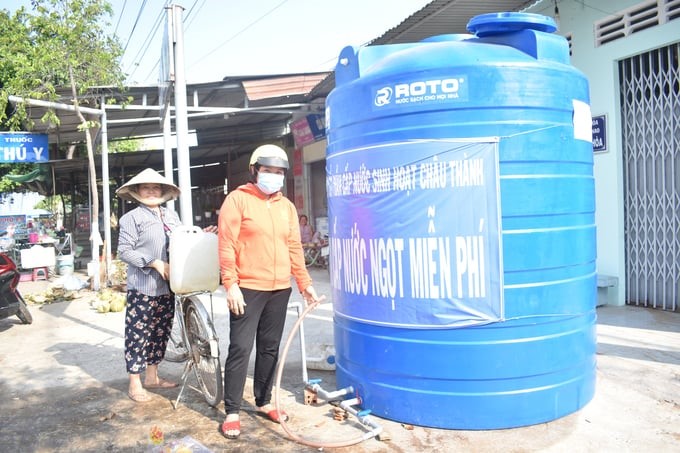
People get water at free water supply stations. Photo: Minh Dam.
In Binh Dai district, the domestic water source for people in Long Dinh, Long Hoa, Chau Hung, and Phu Thuan communes is provided by Long Dinh Water Factory, which has a capacity of about 90 m3/hour. The raw water source is at the head of the An Hoa River, adjacent to the Tien River. For more than a week, surface water salinity has increased, so the water source for people here is saline.
Mr. Tran Van Khoa, Head of Binh Dai Area under the Ben Tre Center for Clean Water and Rural Environmental Sanitation, said: The unit measures salinity twice a day and reports to the Department of Agriculture and Rural Development and localities to notify the people. The salinity on March 13 was 6.1‰; today it decreased to 5.4 ‰. On days of high salinity, the unit receives water (taken from the Ba Lai river source; low salinity is currently only 2.2‰) from the Thoi Lai water factory to combine with water in the factory's pipes to reduce salinity.
According to Mr. Khoa, the salinity in the past week was the highest and has prolonged since the beginning of the dry season. Previously, the unit filtered and reserved 20 m3 of standard clean water. Currently, the R.O salt filtration system is being activated, with a capacity of 2 m3/hour, to pump water into reserve drums, serving people for free. "It is expected that on March 18, fresh water will be transported by barge to supply people," said Mr. Khoa.
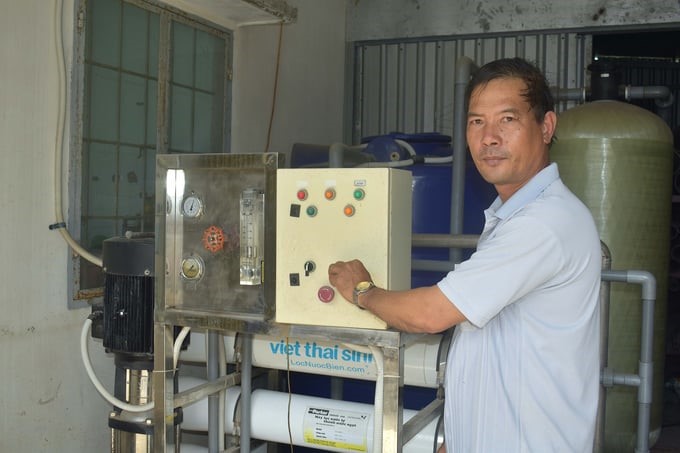
Mr. Tran Van Khoa is operating the R.O salt filtration system to provide free fresh water to local people. Photo: Minh Dam.
Currently, the surface water is saline, so local motorbike washers have to rent tricycles to transport fresh water from the pond. Each 1-m3 drum of water costs VND 150,000, of which the wage for the truck is VND 100,000/trip and the fee for the pond owner is VND 50,000.
“Soap used with salt water doesn't foam. Therefore, I now rent a truck to carry fresh water from the pond to wash customers' vehicles, so the washing price increases by VND 5,000/unit to VND 30,000/unit. This water source is just for washing vehicles; I'll store rainwater for cooking. When bathing, I take a salt water bath and rinse with one fresh water mug," shared Mr. Phan Thanh Hai, Long Hoa commune.
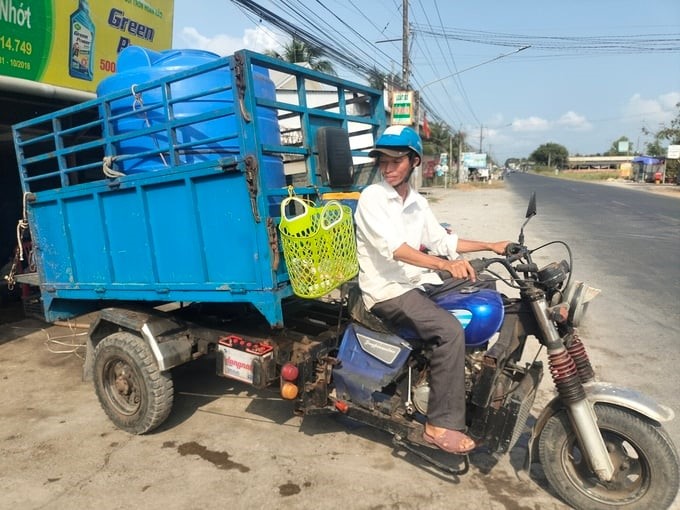
The vehicle wash shop rents motorbikes to transport fresh water from local ponds. Photo: Minh Dam.
“This water is taken from the storage lakes of local people. I have transported for hire for owners in Long Hoa and Long Dinh communes for the past 10 days, with 5–6 trips/day," said Mr. Phan Khac Trinh, Long An hamlet, Long Hoa commune, a hired transporter.
Mr. Bui Van Tham, Deputy Director of the Ben Tre Department of Agriculture and Rural Development, informed: There are 5 factories near large rivers that are using barges to transport fresh water to replenish the pipes 1–3 days per week. Factories in other rural areas supply water through a centralized R.O salt filtration system for free to people.
Mr. Tran Ngoc Tam, Chairman of the Ben Tre Provincial People's Committee, said: "We pay great attention to the province's two large water factories, namely Son Dong and An Hiep. The province has built Thanh Trieu dam, kept a large amount of water in the river beds, and continuously pumped water into those rivers when the fresh water in the Ba Lai River has low salinity. This year, to be more proactive, the province built an additional Cai Co dam to store more water in two tributary rivers. We have directed water culvert systems to open and close appropriately depending on the salinity and drought level."
Currently, Ben Tre province has 67 domestic water factories with a capacity of 250,000 m3/day and night. Raw water is mainly taken from surface water on the main river branches. Currently, the areas of Cho Lach district, Northern Chau Thanh district, and Ben Tre city are basically not affected by salinity. In the remaining areas, tap water for domestic use that is supplied from water factories has become saline. There are 21 factories with salinity below 0.5‰, 6 factories with salinity between 0.5-1‰, and the remaining 40 factories with salinity above 1‰.
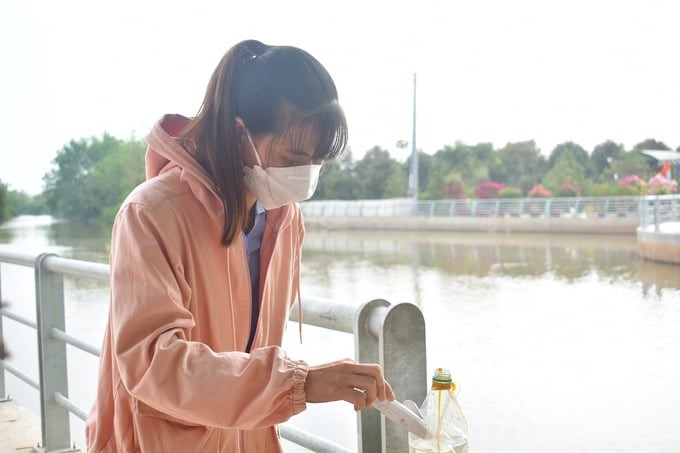
Measuring salinity to get drinking water. Photo: Minh Dam.
At this time, water supply units proactively measure and check salinity and have plans to pump water in accordance with saltwater intrusion developments while providing salinity measurement data for localities and people to have a plan for storing and using fresh water properly. In addition, water factories have also developed a plan to operate the R.O water filtration system to supply water to people.
Statistics from the Ben Tre Department of Agriculture and Rural Development showed that as of March 11, water salinity after treatment from factories in Ba Tri district ranged from 0.1 to 2.4‰, Binh Dai district of 0.1-4.9‰, Thanh Phu district of 0.1-3.8‰, Giong Trom district of 0.1-5.1%, Mo Cay Bac district of 0.1-4.0‰, Mo Cay Nam district of 0.2-4.0‰, and Chau Thanh district of 0.1-1.3‰. Some private water factories measured salinity after treatment, ranging from 0.1-3.5‰.
Translated by Huyen Vu Thu
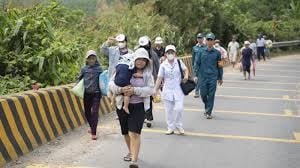
(VAN) The training event held in Hoa Phu (Da Nang) highlighted the importance of incorporating gender factors in order to protect communities from disasters.
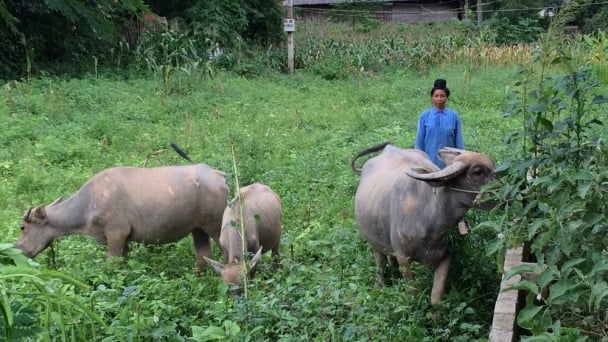
(VAN) Dien Bien province needs to develop alternative livelihoods and strengthen community monitoring to minimize conflicts with biodiversity conservation efforts.
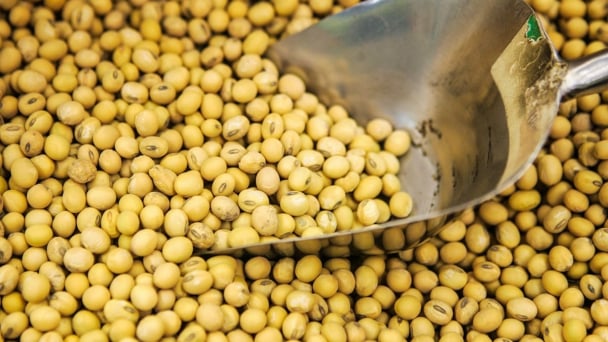
(VAN) The US-launched tariff confrontation has begun to hit American agricultural exports, particularly soybeans and pork, as China's Zhejiang Province is seeing a surge in Brazilian soybean shipments arriving at its ports.
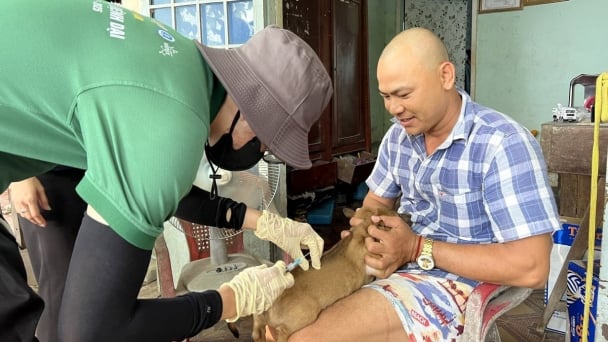
(VAN) Cooperation between organizations, businesses, and local communities has created success in rabies prevention in Duc Hue, Long An over the past 5 years.

(VAN) In a meeting with Japanese Prime Minister Ishiba Shigeru on the afternoon of April 27, General Secretary To Lam proposed that the two countries strengthen cooperation in high-tech agriculture.
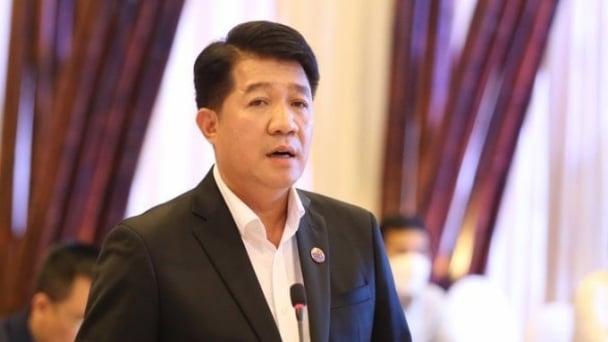
(VAN) 'Vietnam Agriculture and Nature Newspaper will become a specialized forum, quickly and accurately updating information on agricultural policies, environmental protection and sustainable development', said Mr. Vu Manh Hung, Chairman of Hung Nhon Group.

(VAN) Low vaccination rates, unknown origin of breeds, and lack of decisive action by the government are what causes avian influenza outbreaks.